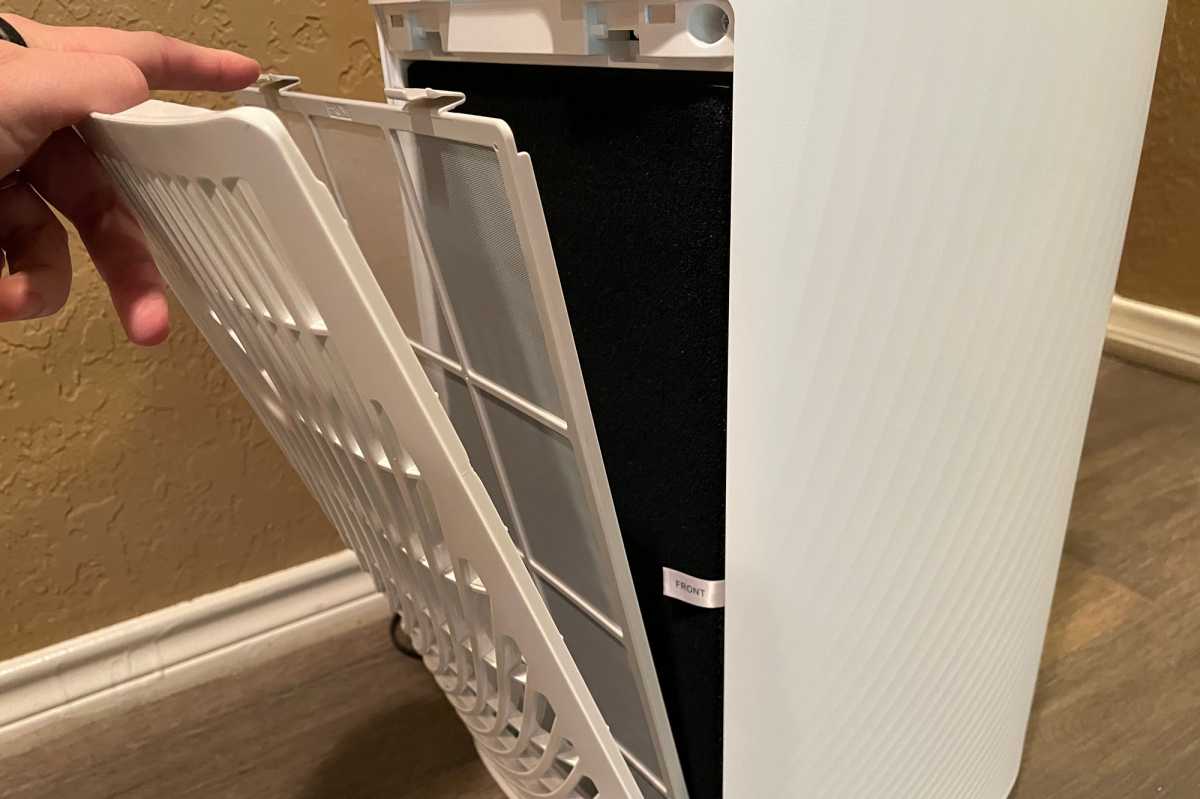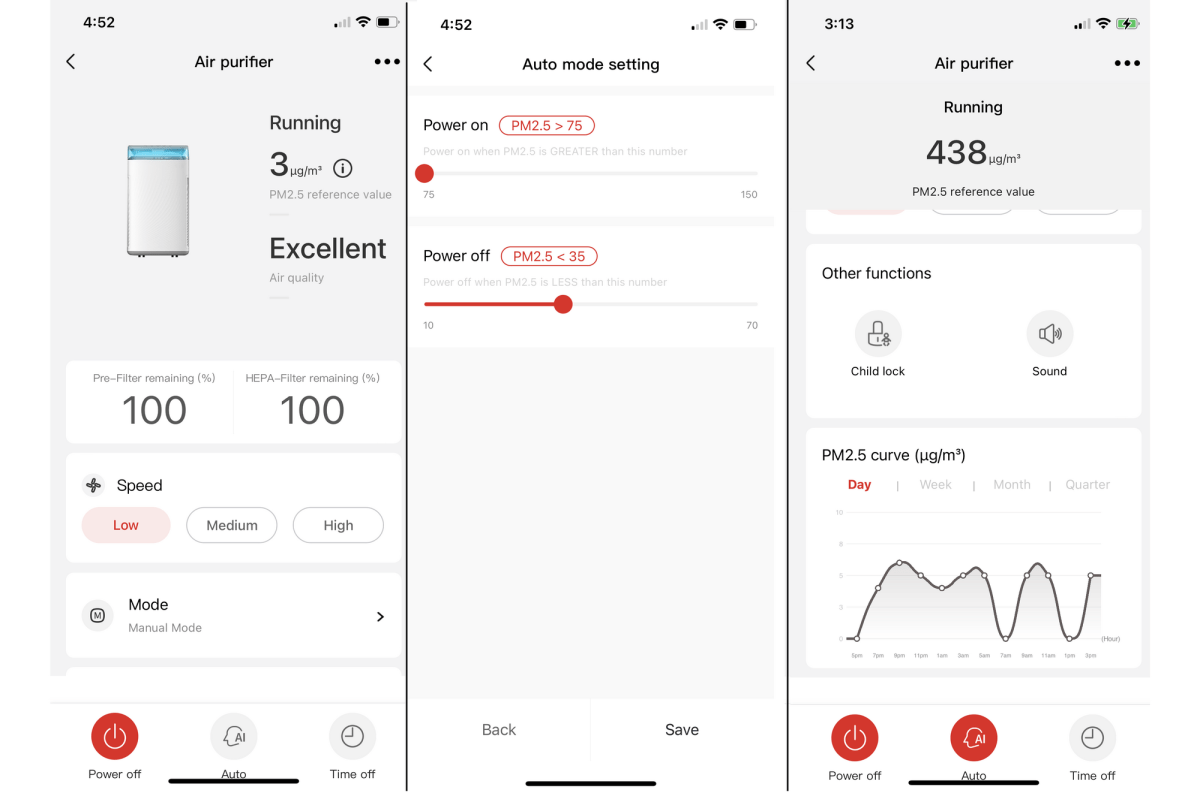Expert’s Rating
Pros
- Very unattractive industrial design
- Auto mode doesn’t work as promised
Cons
- Supports dual-band Wi-Fi
- Quiet, with solid performance
- Effective app
Our Verdict
It’s highly effective at its assigned task, but the Toshiba model CAF-Z85US is one of the ugliest smart appliances we’ve reviewed.
Best Prices Today: Toshiba H13 True HEPA Air Purifier (model CAF-Z40US)

$287.64
An understated design that fits most homes’ décor is what’s in. It seems Toshiba didn’t get the memo. With its CAF-Z85US purifier, the company swings for the Star Trek set, with a wildly overdesigned, albeit effective, beast of an air purifier. Design, of course, is a subjective matter. If you’re looking for something that more closely resembles your washing machine than a sleek end table, then by all means, read on.
Measuring 27 inches high (including its pre-installed casters) and weighing 27 pounds, Toshiba’s purifier is built for large spaces, with maximum coverage of 483 square feet. In a room of that size, the CAF-Z85US can change the air 7 times per hour, with specified CADRs (clean air delivery rates) of 310 cfm (smoke), 295 (dust), and 315 (pollen).
This review is part of TechHive’s in-depth coverage of the best smart air purifiers.
The filtration system is one of the most curious I’ve seen in the category, relying on two standard rectangular HEPA H13 filters that are mounted vertically on either side of the device. Air is drawn in through both filters and emitted upward from a vent in the top. The choice of double filters in lieu of a cylindrical filter (or a single flat filter) is an odd one; in part because it means twice the work in setting it up and in changing filters. Filter changes will also be expensive, as each filter set costs $50.

There are HEPA filters on opposite sides of the Toshiba model CAF-Z85US air purifier.
Christopher Null/Foundry
While the lower half of the unit is fairly tame, the upper portion features a fairly out-there design, which I can best describe as a transparent bowl set atop a silver base. The lower portion of the base offers a busy display of PM2.5 (particulate matter smaller than 2.5 microns) levels, VOC (volatile organic compounds) levels, and “progress bars” that chart the status of both the HEPA and washable pre-filters. A lighted ring around the output grille shifts from blue to red as air conditions worsen.
Controls are found on the upper rim of this bowl, and they’re surprisingly complex, with a speed button that cycles through three power levels; a timer that cycles through 1-, 2-, 4-, and 8-hour countdowns; and a “mode” system that provides sleep, turbo, and “smoke” modes. This last mode is not explained anywhere. There’s also an “AI” auto button that supposedly allows the purifier to turn itself on when conditions are poor and off when they improve. There doesn’t appear to be anything remotely related to artificial intelligence in this function; and in fact, because there’s no indicator light associated with it, you can’t even tell if the mode is turned on or off when you press the button.

The Toshiba CAF-Z85US air purifier’s over-the-top design elements will turn off many potential buyers.
Christopher Null/Foundry
One final feature is a light-sensing function that can turn all the indicator lights off when the room is dark, then back on when it’s light out. That’s a much more helpful feature than the usual all-or-nothing sleep mode.
Functionally, the purifier works well, and its volume level is manageable, even on the highest output setting. One problem: The auto mode does not seem to work as advertised: The unit runs all the time whether the air quality is good or not, although it does at least run at a very low level when the air is clean.
The Toshiba purifier comes with an app called TSmartLife, and pairing it to your phone is a quick affair. Perhaps part of that is due to the fact that the purifier is one of the rare smart home devices that support dual-band Wi-Fi—connecting to either 2.4- or 5GHz networks—which could help avoid the compatibility issues that periodically crop up on devices like this.

Toshiba has come up with an excellent mobile app for its smart air purifier.
Christopher Null/Foundry
The app itself is straightforward, offering a real-time look at PM2.5 and VOC levels and replicating the full suite of controls that are available on the unit itself. As a bonus, you can even tell if the auto mode is on or off though the app—and set the minimum PM2.5 thresholds that turn the purifier on and off. Unfortunately, as noted above, these parameters didn’t do anything no matter how I set them: The purifier was always on no matter what the air quality was.
As a bonus, the unit includes a log of PM2.5 measurements, with average readings charted by day, week, month, or quarter. While a more granular, hourly breakdown might arguably be more useful for some users, any sort of logging is always a plus. Lastly, Alexa and Google Assistant are both supported, offering basic voice control features. $300 is a decent price for a purifier like this with large room capacity, quiet operation, and an effective smart app—and I won’t dock it too much for the AWOL auto mode, which can probably be fixed with a firmware update. The overall design is really the biggest concern here, as I can’t see many aesthetically conscious homeowners feeling comfortable with this occupying in any room where they’d have to regularly lay eyes on it.




